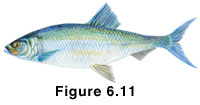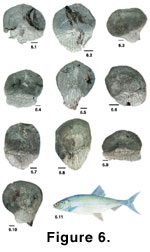 Description
DescriptionClupea harengus pallasi
(Pacific Herring)
(Other common names: Iinang, K'aaw, Skah, Slhele lhong'et, Slhong'e)
Figure 6.11
 Description
DescriptionLength: 46 cm.
Mouth: moderate, terminal, directed moderately upwards; upper jaw extending to midpoint of orbit; teeth in patch on vomer only; upper jaw does not have notch for lower jaw.
Body: elongate with a compressed head; no striations on operculum or head; no scales on head or on caudal region; last dorsal fin ray not elongates; scutes are weakly keeled.
Color: bluish green to olive on dorsal surface shading to silver on lateral and ventral sides; no spots on body.
Depth: pelagic schooling species.
Habitat: inlets, protected waters (e.g., embayments); nearshore waters while young; migrate into deeper waters offshore as adults.
Season: spawning occurs in winter-spring (December-March); occurs in protected waters where there is favourable substrate for egg deposition (e.g., kelp and/or eelgrass beds).
Diet: crustaceans (e.g., copepods, larval stages), molluscs, smaller fish; some phytoplankton species.
Predators: forage species (e.g., sardines, pollock, larger herring), salmon, marine mammals.
Distribution: Baja, California to Alaska to the Bering Sea to the Sea of Japan.
 Scale
Description
Scale
DescriptionRelative Size of Scale: large.
Position of Scales on Body: 51-54 rows along the midside region; midventral line has weakly keeled scutes; and also there are scutes anterior to the pelvic fins and the anus (Hart, 1973).
Overall Scale Shape: circular to oval (G scales tend to be more elongated). In juveniles, the scales tend to be more teardrop in shape with the main circuli portion being semi-circular and the adjoining wing join loosely V-shaped. The overall shape of the wing clips is highly variable. The posterior field attachment tends to be broad and can be straight to gently convex. The outside posterior edge is crenulated and curved. These scales are generally quite flexible mechanically.
Focus and Circuli: the focus varies from indistinct to very distinct. It is often situated just above the posterior field interface and is generally central between the lateral fields, although it is sometimes slightly offset. The circuli are straight to curved, but generally concentric with the outline of the scale. Annuli are generally distinct as a more pronounced ridge (this is less obvious is more circular scales). The circuli are variable within a single scale: some are continuous between fields, others are discontinuous. The circuli tend to be less compacted than in Sardinops, but this is feature is plastic. In regenerated scales the circuli and focal area are quite distorted. In juvenile scales, the circuli are often broken in the center of the scale, showing a reticulated pattern. Circuli do not proceed into the posterior field, although some minor reticulation of the circuli may be present just below the attachment interface.
Radii: there are no radii present, though there are often grooves and fracture lines in the scales that can run traversely across the scale, often crossing circuli. These fracture lines are also somewhat irregular.